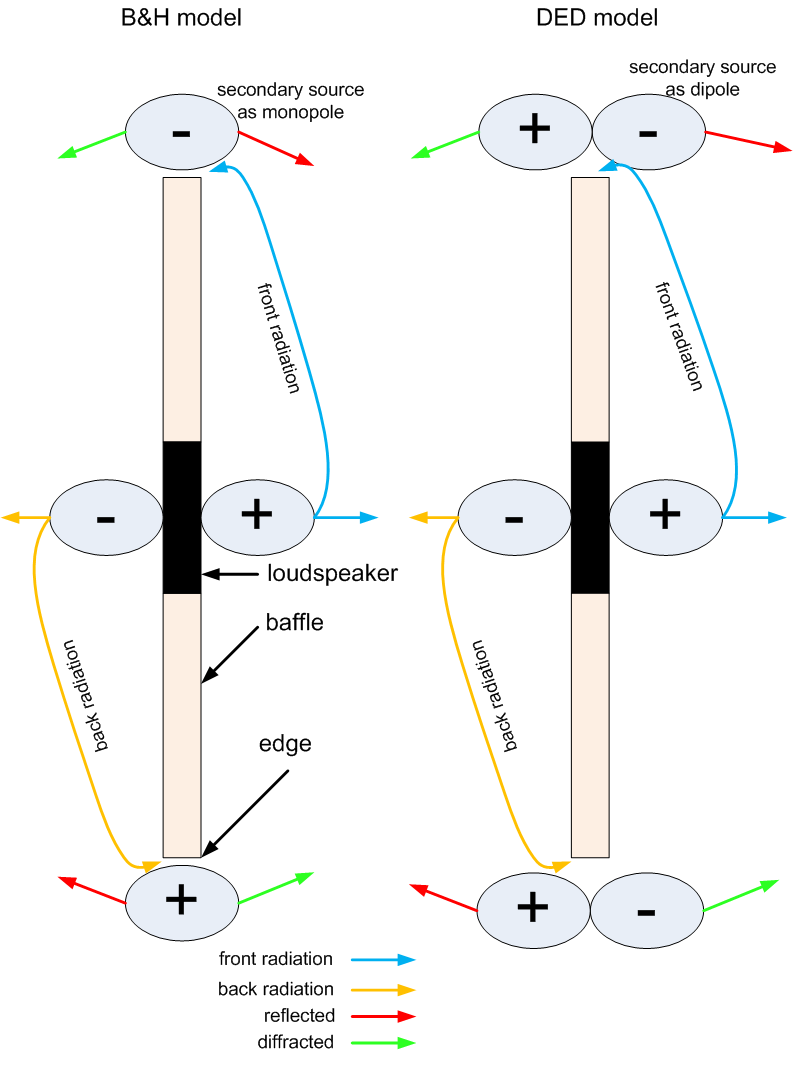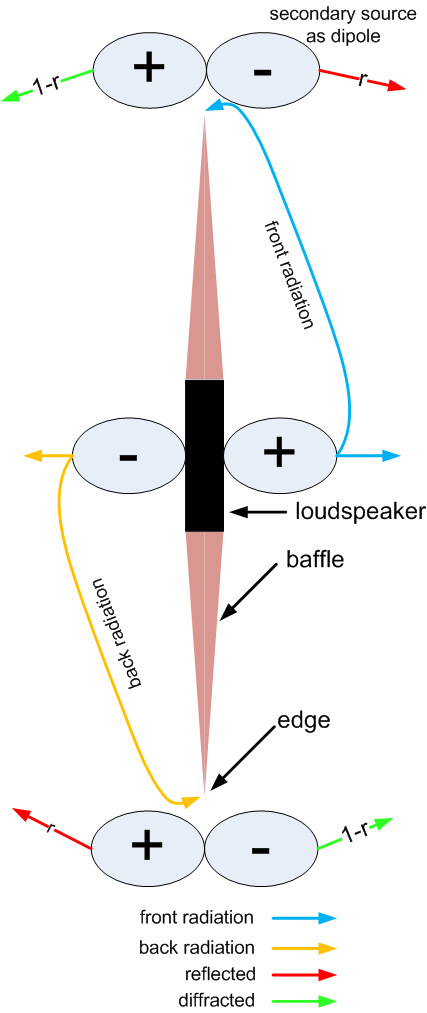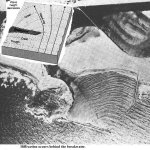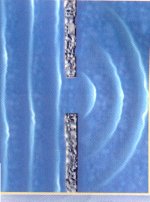Clearly dipole loss and edge diffraction are different. What is also unique about my question is that it has nothing to do with dipole loss...Hi,
Open baffle loss is not the same as baffle diffraction, by a long way.
Edge treatments for baffle diffraction make no sense for OB loss.
Chalk and cheese in reality, and very different approaches.
rgds, sreten.
You guys must be kidding.Clearly dipole loss and edge diffraction are different. ...Hi,
Open baffle loss is not the same as baffle diffraction, by a long way. ...
There is a perfect continuum from the dipole source in infinitely small baffle (point source) with infinitely large edge diffraction (every point radiating equally in every direction) to the dipole source in (almost) infinitely large baffle with (almost) zero edge diffraction.
If you can proof me wrong, would you please state where (frequency/size) edge diffraction stops and dipole loss takes over
Juhazi already linked to Mellow's PDF on the dipole sound field which is very much in line with what I measure. Mellow does not make any difference between edge diffraction and dipole loss.
Rudolf
Rudolf,You guys must be kidding.
There is a perfect continuum from the dipole source in infinitely small baffle (point source) with infinitely large edge diffraction (every point radiating equally in every direction) to the dipole source in (almost) infinitely large baffle with (almost) zero edge diffraction.
If you can proof me wrong, would you please state where (frequency/size) edge diffraction stops and dipole loss takes over
Juhazi already linked to Mellow's PDF on the dipole sound field which is very much in line with what I measure. Mellow does not make any difference between edge diffraction and dipole loss.
Rudolf
I suppose I must have misrepresented myself. What I was trying to say is that I was making no mention of dipole loss and was instead concentrating on mainly the edge diffraction. Edge diffraction can exist on a dipole speaker without baffle loss, in some unique situations, but in any case I am interested in the effect and solution for diffracted waves alone.
Not to be too pedantic but much of the confusion on these topics comes from semantics and careless use of technical terms.
Diffraction refers to the bending of waves around a solid object. Nothing more and nothing less. Without diffraction there would be no dipole response as we know it because none of the energy from the back face of the driver would make it to the front to interfere.
Now, when a lot of people use the term diffraction they are thinking of the reflections that come along with diffraction. This is a misuse of the term. Reflections do occur and are always present when a traveling wave hits a change of acoustic impedance. This can be due to a bend forward in the surface (an increase in impedance that causes a positive reflection) or a bend away in the surface (a decrease in impedance that causes a negative reflection). In the first case there is no diffraction and in the second, assuming the right wavelengths, there is diffraction. But diffraction only refers to the expansion of the wavefront once past the barrier. The reflections may be due to diffraction, but they are not "diffraction".
As to the response of a dipole, the front side far field response is simply the vector sum (phase matters) of the front radiation, the diffracted radiation from the back side of the driver, and any edge reflections from the baffle edges due to the front driver.
Diffraction of the front energy (bending around to partially fill the void behind) is happening but we don't care at all, as we are listening in the front hemisphere. Of course because energy is diffracting around, our baffle is incomplete, and low frequency loss will occur. The increasing low frequency losses are due to the vector sum and the fact that, the lower we go, the less the phase shift due to extra path length and the more complete the loss.
Regards,
David
Diffraction refers to the bending of waves around a solid object. Nothing more and nothing less. Without diffraction there would be no dipole response as we know it because none of the energy from the back face of the driver would make it to the front to interfere.
Now, when a lot of people use the term diffraction they are thinking of the reflections that come along with diffraction. This is a misuse of the term. Reflections do occur and are always present when a traveling wave hits a change of acoustic impedance. This can be due to a bend forward in the surface (an increase in impedance that causes a positive reflection) or a bend away in the surface (a decrease in impedance that causes a negative reflection). In the first case there is no diffraction and in the second, assuming the right wavelengths, there is diffraction. But diffraction only refers to the expansion of the wavefront once past the barrier. The reflections may be due to diffraction, but they are not "diffraction".
As to the response of a dipole, the front side far field response is simply the vector sum (phase matters) of the front radiation, the diffracted radiation from the back side of the driver, and any edge reflections from the baffle edges due to the front driver.
Diffraction of the front energy (bending around to partially fill the void behind) is happening but we don't care at all, as we are listening in the front hemisphere. Of course because energy is diffracting around, our baffle is incomplete, and low frequency loss will occur. The increasing low frequency losses are due to the vector sum and the fact that, the lower we go, the less the phase shift due to extra path length and the more complete the loss.
Regards,
David
Attachments
I think that I agree with Dave (a rarity  ). Diffraction is defined as the sound field which exists in the shadow zone of the source - i.e. the field not directly illuminated by the source. This definition can become problematic when we have an extended source - not a point source - because some points may be in the shadow zone of only part of the source. This later case happens in waveguides where parts of the source illuminate the walls directly but not all of the source. This creates a situation where we have only partial diffraction of the source.
). Diffraction is defined as the sound field which exists in the shadow zone of the source - i.e. the field not directly illuminated by the source. This definition can become problematic when we have an extended source - not a point source - because some points may be in the shadow zone of only part of the source. This later case happens in waveguides where parts of the source illuminate the walls directly but not all of the source. This creates a situation where we have only partial diffraction of the source.
Edge diffraction does not cancel for a dipole. This can clearly be seen by considering that the pressure differential at the edge doubles in the dipole because of the phase differences of front and rear. Doubling the pressure differential will not make the diffraction less. But we must always remember than whenever there is diffraction there must be a reflection so the two things are intimately connected in a way that makes them virtually inseparable. Which is why we often call the forward field from a baffle edge diffraction when in fact it is the forward reflection that results from the true diffraction into the shadow zone.
Edge diffraction does not cancel for a dipole. This can clearly be seen by considering that the pressure differential at the edge doubles in the dipole because of the phase differences of front and rear. Doubling the pressure differential will not make the diffraction less. But we must always remember than whenever there is diffraction there must be a reflection so the two things are intimately connected in a way that makes them virtually inseparable. Which is why we often call the forward field from a baffle edge diffraction when in fact it is the forward reflection that results from the true diffraction into the shadow zone.
But I was wrong : I should have thought by myself instead of reading papers and websitesI think that I agree with Dave (a rarity)
It is a bit strange that there is no specific paper about diffraction of dipoles : many papers are uncomplete (or wrong ?). So to understand the acoustic phenomen, I also drew it. It is more or less the same as what Dave, Dlr and Earl said but often a picture is clearer.
Generally diffraction is modelled as secondary sources reparted on the baffle edge. For loudspeaker enclosure diffraction, what is going backward (the diffracted part) it is less interesting than what is going frontward, so a few models are only valid for the reflected part, neglecting the backward radiation.
But when we talk about dipoles, the diffracted part of the back radiation is also important.
Allthough diffraction is one acoustic phenomen, it is easier to follow Dave's recommendation and to virtually separate the diffracted wave and of the reflected wave, even if both radiations are due to the same cause.
One paper, although not related to dipole loudspeakers, compares three models of diffraction :http://www.l-acoustics.com/aes/DED_model_journal_AES_V52_2004.zip
So I 've done a picture of two models, the B&H and the DED. The first one shows diffraction sources as monopoles and the second one as dipoles.
In the B&H model, diffraction radiation due to front and to back radiation are in phase opposition and cancel (ie on John K web site).
In the DED model, they have same phase and add.
Modelling the diffraction sources as dipoles seems to explain everything from dipole cancellation to diffraction wiggles on frequency response.
But what seems not so clear is the practical value of the reflection coefficient, see http://www.google.fr/url?sa=t&rct=j&q=&esrc=s&source=web&cd=1&cad=rja&uact=8&ved=0CCMQFjAA&url=http%3A%2F%2Fwww.torean.dk%2Fartikel%2FDiffraction.pdf&ei=MgKsVISOCMH7UqX-g8AL&usg=AFQjCNGMZD17ztim-U8KpcSSTN5hgoRWpw&bvm=bv.82001339,d.d24

Interesting references, thanks for that.
So which drawing is correct?
I was unaware that the diffraction reflections were essentially dipole sources, but it works for me.
With the B&H model, it makes no sense to state that the diffracted energy has its phase flipped as it passes the edges. This is not the case for any visible phenomena, such as wave tanks, so it wouldn't be true for acoustical waves.
Regards,
David
So which drawing is correct?
I was unaware that the diffraction reflections were essentially dipole sources, but it works for me.
With the B&H model, it makes no sense to state that the diffracted energy has its phase flipped as it passes the edges. This is not the case for any visible phenomena, such as wave tanks, so it wouldn't be true for acoustical waves.
Regards,
David
The correct model is the DED with dipoles.Interesting references, thanks for that.
So which drawing is correct?
I was unaware that the diffraction reflections were essentially dipole sources, but it works for me.
Interesting also is that with a dipole loudspeaker, at listening place, you get the direct sound and after some time (due to baffle dimensions), you get the front reflection from edge and at same time the diffraction from back radiation. But no matter what the reflection coefficient is, the theoretical sum of reflection + diffraction is allways unity.
Something I did years ago. A very simplistic look at edge diffraction for dipoles.
Dipoles and Diffraction
Dipoles and Diffraction
I was unaware that the diffraction reflections were essentially dipole sources, but it works for me.
Regards,
David
Hi Dave
It is easy to see that each surface, front and rear has a line of diffraction sources - monopoles - along the edges, but the front and rear are out of phase, hence they become dipoles. I think that Jlo's drawings are trying to show that. If the dipole baffle has thickness then this increases the dipole moment.
If the dipole baffle has thickness then this increases the dipole moment.
And a "razor-sharp" edge would minimize that dipole moment ?
Could it be zero then ?
Yes, but as your model defines secondary sources as monopoles, diffraction cancels for dipole loudspeakers and this is not correct (same problem as with the B&H configuration).Something I did years ago. A very simplistic look at edge diffraction for dipoles.
I think that even with a infinitely thin edge, diffraction source is to be modelled as a dipole.Hi Dave
It is easy to see that each surface, front and rear has a line of diffraction sources - monopoles - along the edges, but the front and rear are out of phase, hence they become dipoles. I think that Jlo's drawings are trying to show that. If the dipole baffle has thickness then this increases the dipole moment.
Hi Dave
It is easy to see that each surface, front and rear has a line of diffraction sources - monopoles - along the edges, but the front and rear are out of phase, hence they become dipoles. I think that Jlo's drawings are trying to show that. If the dipole baffle has thickness then this increases the dipole moment.
Hi Earl
Happy New Year
So you are saying that the dipole edge sources only pertain to the case of the dipole baffle? I though he was defining diffraction re-radiation sources as always being dipoles?
I guess that makes more sense (monopoles combined to make dipole sources).
David
The correct model is the DED with dipoles.
Interesting also is that with a dipole loudspeaker, at listening place, you get the direct sound and after some time (due to baffle dimensions), you get the front reflection from edge and at same time the diffraction from back radiation. But no matter what the reflection coefficient is, the theoretical sum of reflection + diffraction is allways unity.
I don't understand this.
Can you explain it more?
Yes, but as your model defines secondary sources as monopoles, diffraction cancels for dipole loudspeakers and this is not correct (same problem as with the B&H configuration).
Nothing wrong with it. It is a matter of how things are decomposed.
Something I did years ago. A very simplistic look at edge diffraction for dipoles.
Dipoles and Diffraction
John, I can't see this in the list on Tech Studies main page! Please add it! I think that I have seen it earlier and have been looking for it.
Bet this discussion is still missing What happens at higher frequencies above first dipole null - John! Basically we loose dipole summation and then gradually edge diffractions effect gets relatively greater, right? Say for an example a single driver dipole in wide baffle.
Last edited:
Can you explain it more?But no matter what the reflection coefficient is, the theoretical sum of reflection + diffraction is allways unity.
I don't understand this.
The value of the reflection coefficient (called r in following picture) does not seem to be so clear, between 0.5 and 0.7 ? see http://www.torean.dk/artikel/Diffraction.pdf
But in case of dipole loudspeaker, as the diffracted (1-r) and reflected (r) waves sum to unity in the front field, it is not so important to know the r value. I added it on the picture.

With this model, dipole cancellation is just one effect of diffraction.Basically we loose dipole summation and then gradually edge diffractions effect gets relatively greater, right? Say for an example a single driver dipole in wide baffle.
Compared to incident wave, the reflected part has to be opposite in polarity and the diffracted part has to be of same polarity. I don't understand how a monopole diffraction source could give this.Nothing wrong with it. It is a matter of how things are decomposed.your model defines secondary sources as monopoles, diffraction cancels for dipole loudspeakers and this is not correct (same problem as with the B&H configuration).
Last edited:
- Status
- This old topic is closed. If you want to reopen this topic, contact a moderator using the "Report Post" button.
- Home
- Loudspeakers
- Multi-Way
- Baffle edge diffraction with dipole radiation

